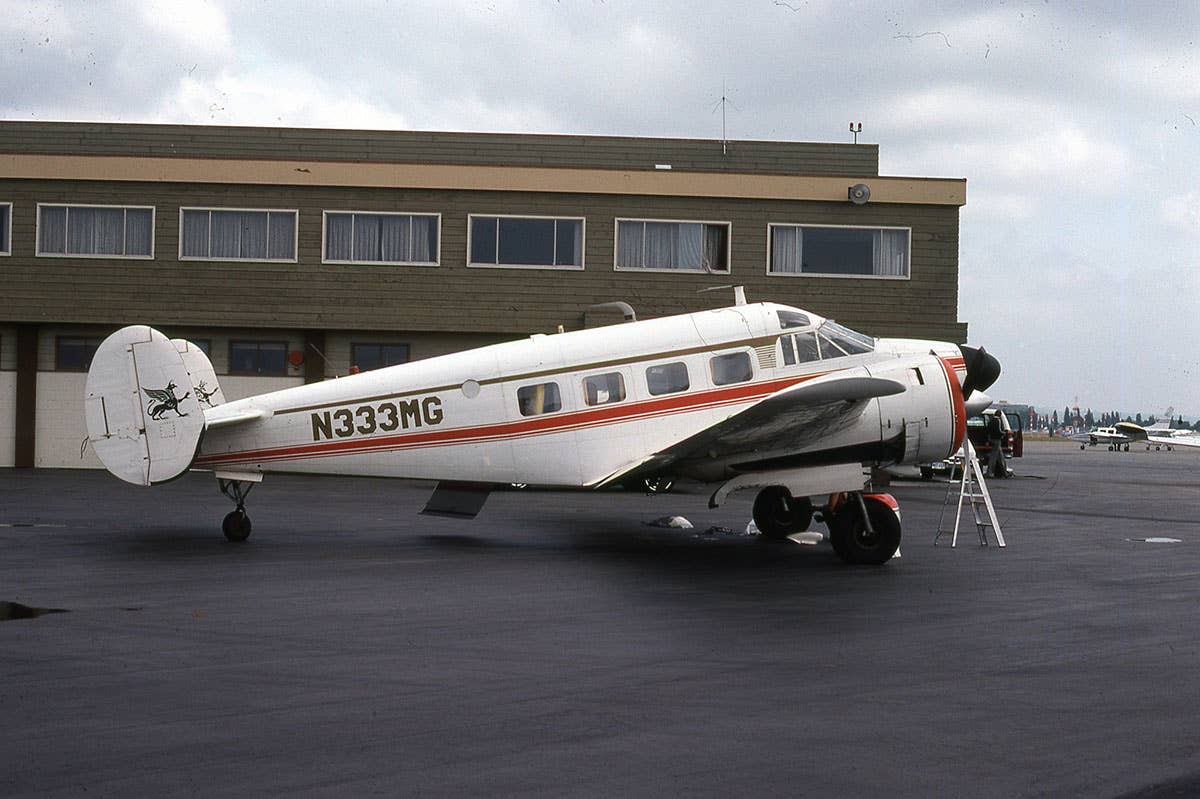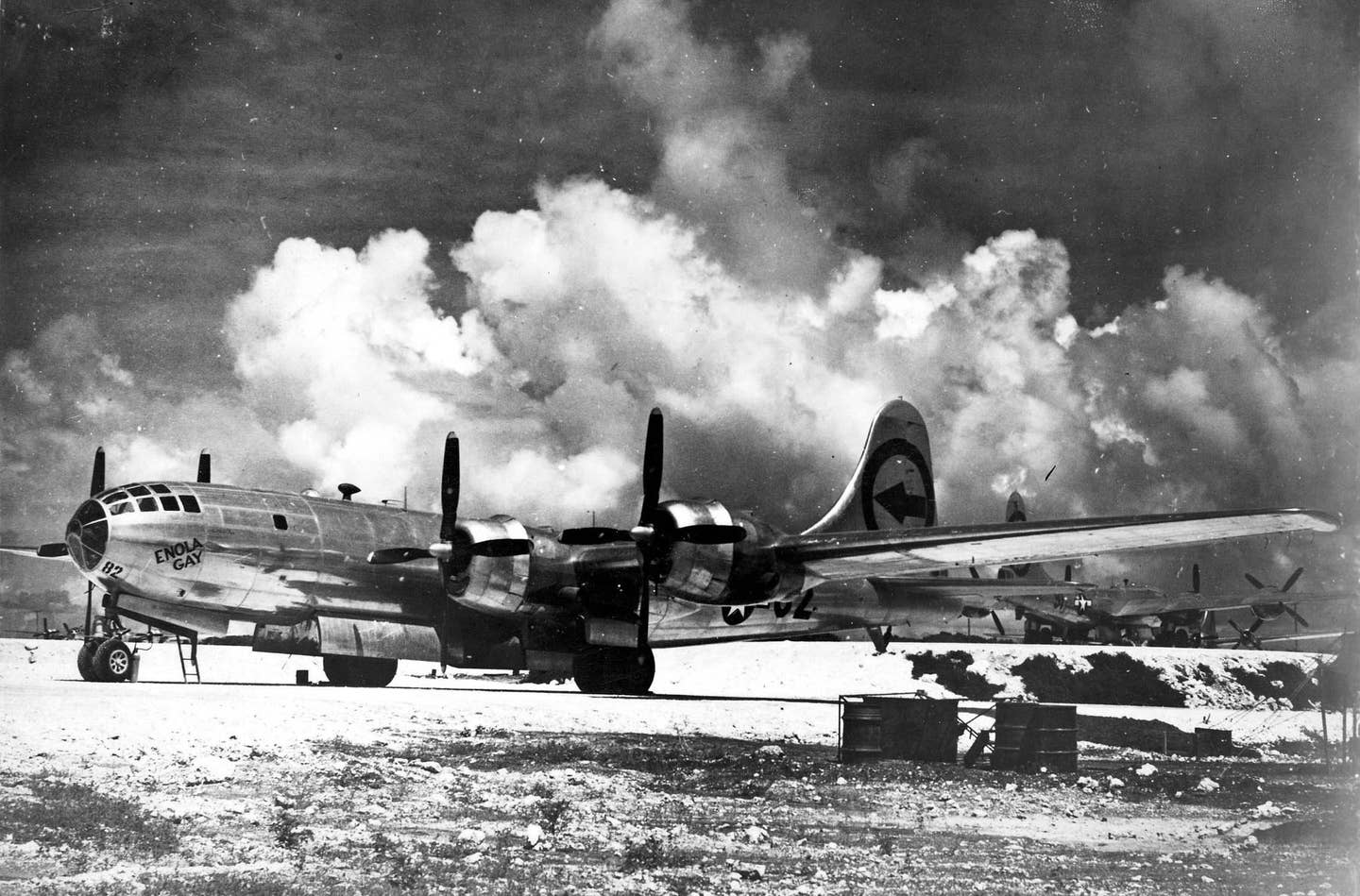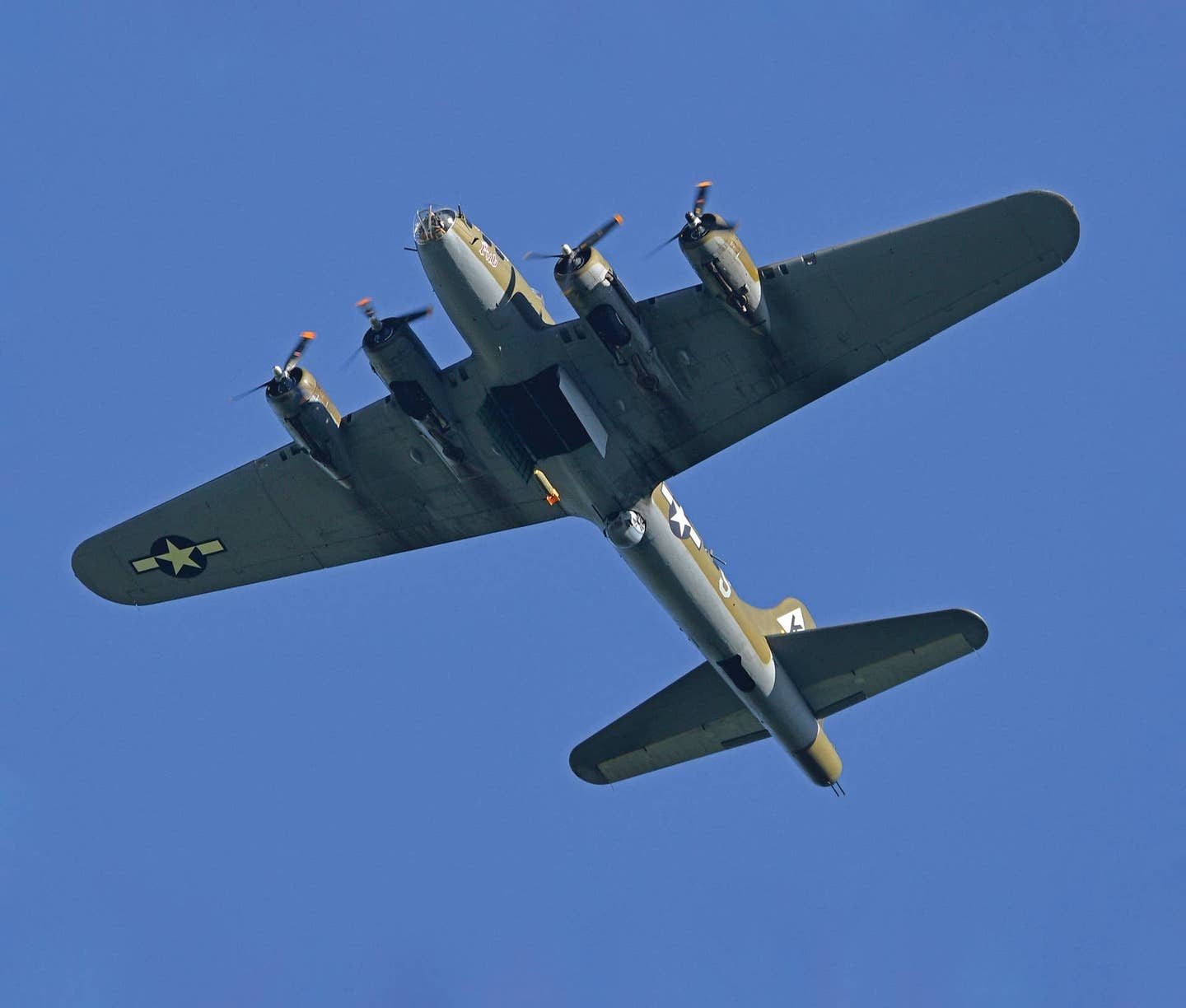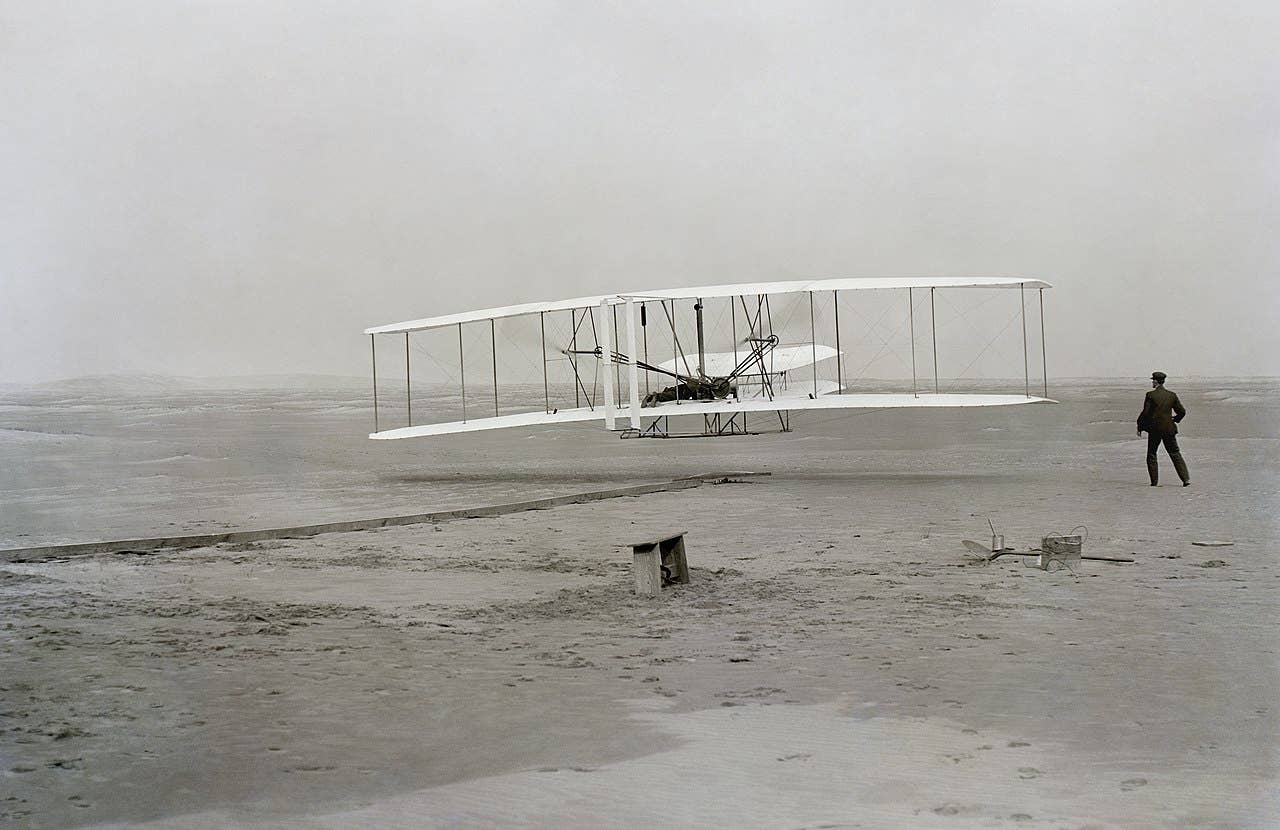Restoring a Beech Super 18 to Former Glory
The Vintage Flying Museum plans to fly the Beech Super 18, once owned by aviation pioneer Jackie Cochran and entertainer Merv Griffin, to air shows to promote the history of women in aviation.

The Vintage Flying Museum in Fort Worth is restoring this Beech Super 18 that was once owned by Jackie Cochran and Merv Griffin. Note the Merv Griffin Enterprises logo on the tail in this image, circa 1970s. [Courtesy: Vintage Flying Museum/Colin Adcock]
A Beechcraft Super 18 that was once owned and flown by Jackie Cochran is being restored to its former glory. Cochran, who directed the civilian Women Airforce Service Pilots (WASP) in the 1940s, holds the distinction of being the first woman to break the sound barrier.
Once it is airworthy—volunteers project a first flight by July 2023, in time for EAA AirVenture at Oshkosh—the classic business air transport will be used to promote the history of women in aviation as a flying exhibit for the Vintage Flying Museum in Fort Worth, Texas.
According to Bill Goebel, the museum’s volunteer crew chief for the restoration project, the Beech Super 18, N13JC, was the last airplane Cochran flew. “She was in her mid-60s at the time when she owned the airplane [1969-1971], and stopped flying it because she was unable to renew her FAA medical certificate due to illness. Aircraft logbooks indicate her last flight was on April 4, 1971,” he says.
However, Cochran’s ownership of the radial-powered twin is only part of its storied past.
After losing her certificate, Cochran sold the 1954 E18S-9700 model to Anthony Productions—the copyright holder for The Merv Griffin Show and Dance Fever.
“Merv actually flew the hell out of it,” Goebel says. “He basically used it instead of driving the [Hwy.] 405.”
Thanks to the detailed logbooks of Griffin’s corporate pilot, the names of the rich and famous, who traveled with him around the Los Angeles area and on junkets to Las Vegas and Palm Springs, were fastidiously documented. According to the flight logs, the list of celebrity passengers included: Clint Eastwood, Burt Reynolds, Leslie Uggams, Gene Hackman, Wayne Rogers, Dinah Shore, Arthur Murray, Dick Carson, Jan Michael Vincent, Marty Allen, Pamela Mason, Doug McClure, and others.
“[And] Dar Robinson, a big stuntman from the era, jumped out of it over Caesars Palace in Vegas,” Goebel says.
It is this history of transporting Hollywood actors and actresses that inspired the twin Beech’s new moniker: the Hollywood Bomber.
“While Jackie is part of the story, she is not the whole story,” says Goebel, an FAA-certified airframe and powerplant (A&P) mechanic with inspection authorization (IA), and an FAA-designated engineering representative—vintage (VDER).
“[The Beech Super 18] is an absolute reflection of corporate aviation in the ’60s and ’70s. It’s really neat, the connection with Hollywood….A lot of famous people flew in this thing—and that’s what you did in the ’60s and ’70s and these were the kinds of corporate aircraft [used], and that’s the story and it’s a great story to tell.”
To note: Goebel acknowledges the Beech Super 18 is not and was never a “bomber,” but he thought it was a catchy misnomer for the project, and the Vintage Flying Museum (VFM) agreed.
Bringing the Aircraft Back to Life
The Beech Super 18 came to the museum in 2019 after serving as a maintenance trainer for Tarrant County College. The aircraft sat outside for most of its 30-year lifetime at the college, exposed to often-harsh North Texas weather conditions.
After learning that Cochran owned and flew it, the college then started “restoring” it, says Goebel, who served on and chaired the aviation advisory committee at the college for several years. “They started basically disassembling it; unfortunately, they didn’t get a lot put back together.”
“It’s one of the larger projects we’ve taken on,” admits Bill Gorin, A&P, IA, and the volunteer director of operations at VFM. “You’re taking an airplane that’s been asleep for 40 years, basically, and trying to wake it up and get it flying again.”
Because of its extended time outside in the elements, every steel screw was rusted and is being replaced, he says. “We’re having to change a lot of nuts and a lot of screws.” The airplane’s belly skin was also replaced, owing to corrosion that was likely caused by an onboard potty.
While the Pratt & Whitney R-985 engines are mid time, they remain a question mark for the project. “We’ve inspected the engines, but there’s still a lot of unknowns with them,” Gorin says.
According to Goebel, the plan is to track the engines’ performance with oil analysis and monitoring, eventually overhauling both engines using a rotable in order to keep the aircraft available.
Of course, if a large-enough donation comes in, Gorin says they will overhaul the engines much sooner. “It’s about $50K per engine, plus the cost of the accessory overhauls. We would love to find someone to donate that, as well as upgrading the old generators to modern Jasco alternators.”
The museum has established a GoFundMe account for monetary donations. The current fundraising goal is listed at $103,000.
Before it goes airborne, the Hollywood Bomber will have new, updated avionics and be completely rewired. Some upgrades are also planned, including adding external oil filters on the engines. “There’s a pre-oil system out there that’s available for it, to pre-oil the engines before you start them, so that way you’re not starting the engines on dry bearings,” Gorin says.
A new paint job and restoring the interior, including new upholstery, will likely be the final touches for the project—most likely after it’s airworthy.
“The biggest challenge is just trying to get all the parts,” Gorin says. “If people want to donate money, or parts, or services, we’re a nonprofit, it’s all a tax write-off for anybody who’s interested.”
The project has already received several donations. These include: an S-Tec autopilot from Genesys; fabrics for the interior from Duncan Aviation; clocks from Davtron; fuel cells and installation from Southwest Airframe and Tank Services; and a spar X-ray from Apex Inspections.
Volunteer Labor Fuels the Project
Goebel, who is documenting the restoration project on his YouTube channel, HangaRatz, says without the support of volunteers, the restoration project would be at a standstill. “Everything is pro bono as far as labor goes. It’s all just community helping this aircraft get back [in the air],” he says.
Some of the volunteers have never worked on an airplane before, and Goebel says that’s OK. As the A&P of record, he is teaching and coaching the volunteers through the entire process.
For example, “The instrument panel was hand-crafted by volunteers who have never built one. No computers. No CAD. No high-speed routers. Drills, punches, and files. And it’s a gold-plated example of their capabilities and efforts,” Goebel says.
One of those volunteers is Abigail Kennedy-Dominguez. The high school senior started helping with the project before the COVID-19 pandemic slowed its progress. Early-on, she says she learned some of the basic skills and techniques to help maintain the airplane. Now that she’s older, she’s been able to participate in more hands-on activities, including helping to cut and file the new instrument panel, sealing and patching holes in the fuel bay, fitting patches for antenna holes in the belly, and taking apart old seats so they can be reupholstered.
“I believe that it's important to maintain a woman's touch on this plane,” Kennedy-Dominguez says. “Jackie Cochran created a legacy for all women in aviation by introducing the idea that women were just as capable as men when it comes to flying (and all things). I think it would be disrespectful for us to ignore that legacy by restoring the plane with a group solely made of men. A woman made that plane glorious, and women should be involved in returning it to glory again.”
Katrina Lorenzen and her husband, Joey, are also helping with the project. When they’re not working on the Hollywood Bomber, they’re building a Van’s Aircraft RV-7A at their home. From transcribing the Beech Super 18’s logbooks to drilling out old rivets, removing the mounting stations and helping final fit and rivet filler plates to patch the old holes, she’s integrally involved with the project.
“This plane has a rich history and the more stories we uncover, the more driven and connected we feel to the project. We are all committed to getting her in the air and off to share with everyone we can,” Lorenzen says.
A Female-Centric Vision
Lorenzen and Kennedy Dominguez’s contributions to the Hollywood Bomber project align well with the museum’s vision of using the flying exhibit to celebrate women in aviation, past, present, and future.
“It’s all about showcasing aviation opportunities for women,” Goebel says.
Gorin agrees. “Ideally, what we’d love to see is that airplane flown and maintained by women. I would love to see it go to shows with a couple of women flying it and women maintaining it. That would be better for the next generation than the current generation.”
Believed to be one of only a few women in the U.S. to found and direct a flying museum, Charlyn “Chuckie” Hospers, couldn’t agree more with the vision for the Beech Super 18, and she’s already creating educational curricula and displays to accompany it. For example, a traveling exhibit of display boards the museum designed and built—available through the Texas Trail Lakes Region—salutes women’s contributions to aviation and World War II. “Two of the panels are on Jackie Cochran, and we have panels with Rosie the Riveter…and we have Wally Funk [and others],” she says.
Forming a Flying Museum
Hospers and her husband, William “Doc” Hospers, purchased the museum's 9-acre site and two hangars—one a B-29 World War II-era hangar—located at Fort Worth Meacham International Airport (KFTW) in Texas in 1988. “We actually started with a B-17 Flying Fortress that we had for 31 years,” she says. The couple were co-founders of the B-17 Co-op, which to this day supports owners of the famed World War II bombers.
Hospers recalls her first introduction to the B-17 that would ultimately become the museum’s first aircraft. “It turned out when my husband came home with the B-17 Flying Fortress, he didn’t tell me at first,” she says. “He flew it in and had me meet everybody out at the airport. And he took me by my hand and led me underneath the wing of the aircraft, and he said, ‘What do you think of this?’ And I said, ‘What is it?’ And he said, ‘It’s ours.’ That’s how it started. He had taken a big stick and painted my name on the side of the nose of the B-17. He knew what he was doing.”
Hospers says she got on the “bandwagon,” learned to fly, got her taildragger endorsement and her multiengine rating. “We had it [the B-17] for 31 years, and we flew it to airshows and it was all volunteers that maintained it and kept it flying,” she says. Following Doc’s death in 2010, she sold the B-17 named Chuckie. Today, the vintage bomber is owned and operated by the Erickson Aircraft Collection in Madras, Oregon.
A former FAA runway safety expert, Hospers says “it’s amazing” how far the museum has come since it was incorporated as a nonprofit in 1990. Today, several other aviation-related nonprofits call the museum home, including the CAF Invader Squadron, PGM Aviation, Greatest Generation Aircraft, and the Fort Worth chapter of the American Rosie The Riveter Association.
“We have almost 30 aircraft on display now [about 50 percent airworthy], and some very rare and valuable,” Hospers says.
The famed flying B-29 Superfortress FIFI and B-24 Liberator Diamond Lil called VFM home for seven years before moving in 2021 to the Commemorative Air Force’s new headquarters at Dallas Executive Airport (KRBD). And, the space they left has already been filled. “We actually have a waiting list for aircraft,” Hospers says.
Hospers, Gorin, and Goebel and their team of volunteers are working diligently to get the Hollywood Bomber back in the air. Gorin, who is a pilot, says one day he’d like to fly right seat in the aircraft—after he gets a couple more ratings. “[But] I’d rather stand back and watch the ladies fly it, that would be more rewarding to me.”
Specifications: Beechcraft Super 18 E18S-9700
| Engines: | Pratt & Whitney Military R-985-AN-14B (2), 450 hp each |
| TBO: | 1,200 hours |
| Propeller: | Hartzell, three-bladed HC-B3Z30-2E |
| Seats: | Maximum 10 (2+8) (N13JC is 2+5) |
| Wingspan: | 47 ft., 8 in. |
| Length: | 34 ft., 2 in. |
| Height: | 9 ft., 8 in. |
| Basic Empty Weight: | 6,175 lb. |
| Maximum Takeoff Weight: | 9,700 lb. |
| Maximum Cruise Speed: | 195 knots |
| Range: | 1,000 nm |
| Maximum operating altitude: | 26,000 ft. |

Sign-up for newsletters & special offers!
Get the latest FLYING stories & special offers delivered directly to your inbox






